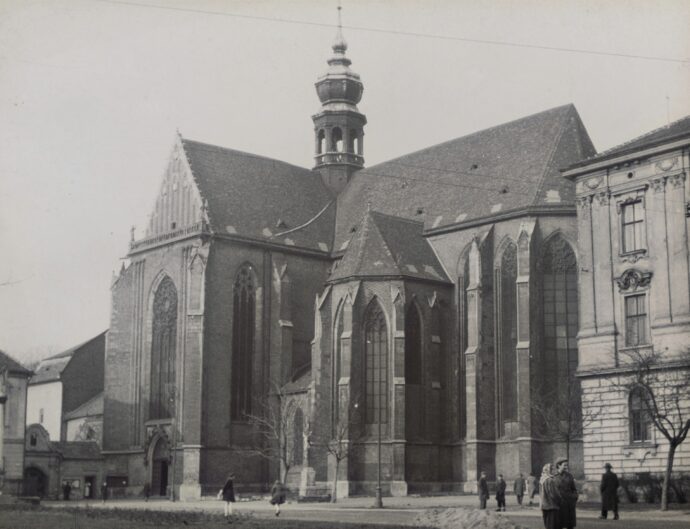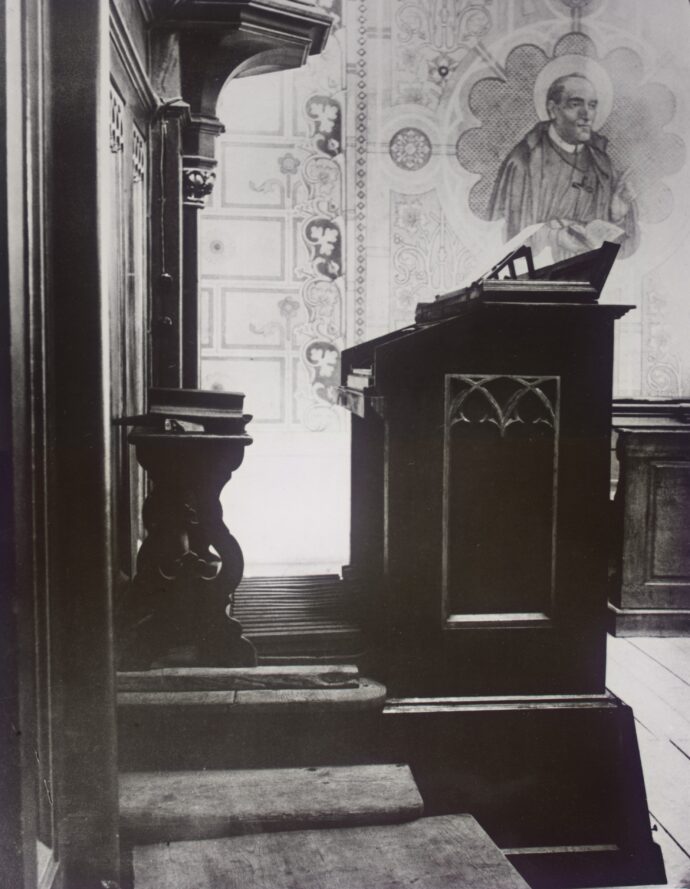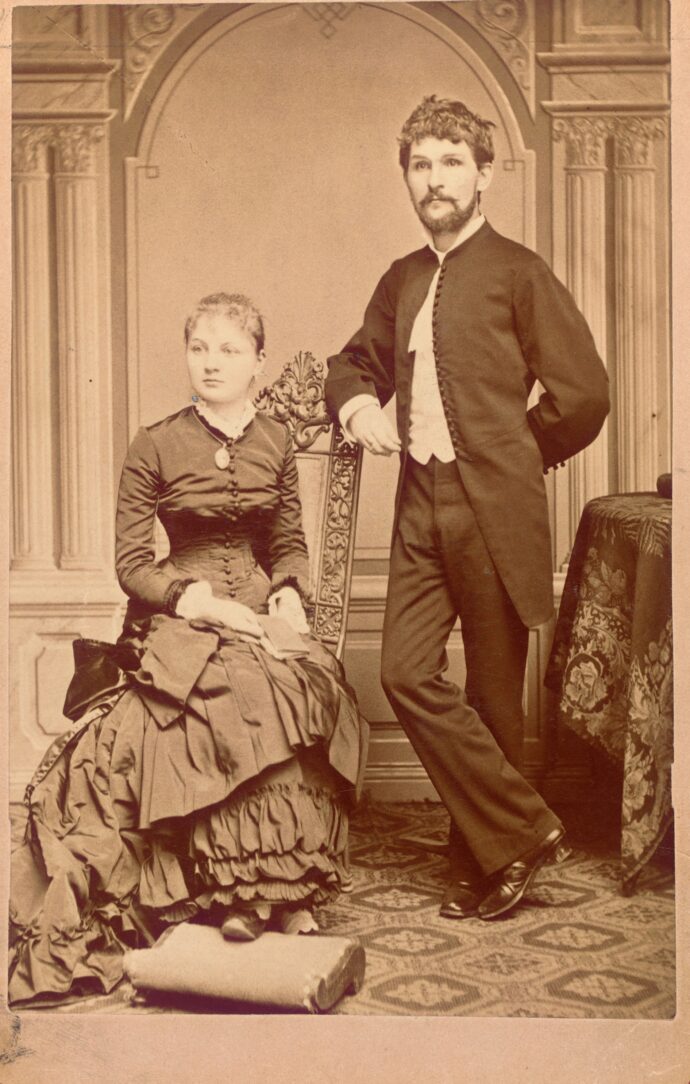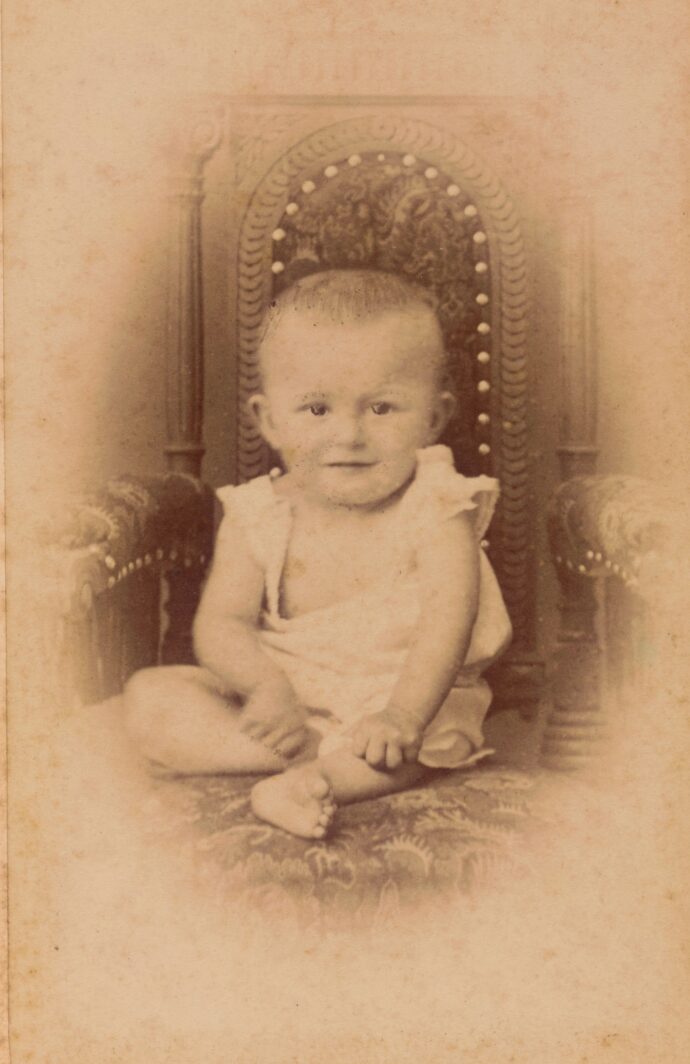A biography of Leoš Janáček
The year is 1854; it is the third of July. A ninth child has just been born into the family of the teacher Jiří Janáček and his wife Amálie; he is given the names Leo Eugen. He has come into the world in the Hukvaldy school where his father teaches and which Leoš will attend as pupil. Who’d have thought that one day the school building would carry a memorial plaque with the name of the new-born boy?
Bluebirds! That’s what everyone in Brno called us, the boys of the Thurn-Valsassina Foundation, after our light blue uniforms bordered in white.

Aged 11, Leoš Janáček arrives at the school attached to the monastery in Staré Brno. Alone, without his parents and friends, he is to study music at the foundation for musically gifted boys from indigent families. It is September 1865. What made the family decide to send the boy away from his native village into the city? It was his father’s illness and lack of money. The foundation is an opportunity for Leoš to receive education and support, and few places could provide a better training in music.
The ‘Bluebirds’, the foundation scholars, practise every day from 5am to 7pm under the strict guidance of the composer and choir director Pavel Křížkovský. You can hear them during masses at the Basilica of the Assumption of our Lady, in music productions at the monastery and in concert and theatre performances. Don’t imagine a bunch of clumsy pupils, taking up their instruments for the first time. Many play skilfully and together they learn really quite difficult pieces.
At the monastery, the boys encounter major figures such as the enlightened Abbot Cyril Napp and the father of genetics Johann Gregor Mendel.



“My parents wanted me to be a priest or a teacher, but what grows inside will not yield. I became a musician. I think it was a happy choice and it has suited me.”
We’re now in the 1870s. Aged 20, Janáček is a graduate of the Teachers’ Institute, but music is a stronger draw than teaching. His further studies too are music-oriented: he enrols at the Prague Organ School. During his studies, he is the choir director at an artisans’ association, Svatopluk, and deputises for his former teacher Pavel Křížkovský as choir director at the church attached to the Staré Brno monastery. He also composes and meets a man who will become his friend for many years: Antonín Dvořák.
It was a close call: Janáček almost didn’t complete his studies. He was more daring than appropriate for a student at the time. In the Cecílie journal, he criticised the performance of a Gregorian mass, led by František Skuherský, the director of his school. The result? Expulsion, with immediate effect.
Don’t worry, it all works out in the end. Pavel Křížovský puts in a word for Janáček, and he completes his studies.
Janáček returns to Brno and starts teaching at the Teachers’ Institute; and Brno receives a boost for its concert programme. Janáček organises, composes, conducts and successfully leads the choir of the Beseda Brněnská philharmonic association. It is thanks to him that the association stages performances of Mozart’s Requiem, Beethoven’s Missa solemnis and Dvořák’s cantata Stabat mater.
We are in times where it behoves girls from good families to be able to play the piano. The director of the Teachers’ Institute, Emilian Schulz, therefore pays for lessons for his daughter Zdenka – and Janáček gives them. The young people soon fall in love, but Janáček wants to study music more deeply. That’s one of the reasons why in 1879 he leaves for the conservatoire in Leipzig and, later, in Vienna.
Contrary to expectations, he doesn’t forget his piano pupil. He continues to send her letters and composes Zdenka Variations for piano. After two years, he returns to Brno, becomes a full-time teacher at the Institute. The next year Leoš and Zdenka are married.
In 1882, their daughter Olga is born. However, the young couple find they do not understand each other as well as they probably imagined before the wedding. Six years later, a little brother, Vladimír, joins Olga, but he dies of scarlet fever at the age of two.



“The tones, the tonal cadences of human speech, and of every living being, have always held the deepest truth for me.”

1881 is not just the year of Leoš’s and Zdenka’s marriage. Thanks to his efforts an organ school is established in Brno and he becomes its director. He serves there until 1919 and is instrumental in the school becoming a conservatoire. He shares his original views of music theory with his students.
According to Janáček’s theory, melody and rhythm are inherently based on the melodies of natural speech. Living speech inspires him in his own composing, but he also finds insights elsewhere, be it a dog barking or parquetry creaking.
Where’s that little boy from Hukvaldy, who came to Brno alone and virtually penniless? The man we now encounter is a respected figure in Brno, who is not missing at any important cultural event.
Janáček’s first opera has seen the light of day, but for now it must remain on paper. This is Šárka after Julius Zeyer, who did not allow Janáček to use his libretto. Janáček will first see his work on stage only in 1894. It won’t be Šárka, but his second opera, The Beginning of a Romance.
He is interested in folklore. Have a look in the collection, A Bouquet of Moravian Folk Songs, or listen to the Lachian Dances and you’ll see how important folk art was to Janáček as a source of inspiration.
“At the time of composing Její pastorkyňa, I absorbed the melodies of spoken words […] Furtively I listened to the talk of passers-by, read their facial expressions, darted my eyes after any movement, noted the surroundings of the talkers, their company, the time, light and gloom, chill and warmth.”

Now comes the moment we’ve all been waiting for. Janáček has completed Její pastorkyňa!
Is it a moment of great glory? No, it’s an incredibly difficult period. The Janáčeks lose their daughter Olga, who dies before 21 years of age. It is a terrible blow to her father.
The famous opera Její pastorkyňa is composed in 1903, initially to no great acclaim. After the National Theatre in Prague refuses to stage it, a production is mounted at its Brno counterpart, but it fails to bring Janáček nationwide acclaim.
Janáček loses confidence, some of his works end up in flames. It is 1914, he is 60 and if you were to tell him that he would once be the most performed Czech opera composer, he’d be unlikely to believe you.
“So it’s certain, 16 February, Saturday, the first performance of Její pastorkyňa at the Court Opera.”
Do you feel the tension? This is a watershed in Janáček’s career – and he is already 62.
What’s new? The Prague National Theatre has produced Její pastorkyňa! Although the conductor Karel Kovařovic has stipulated extensive changes, the performance under his baton starts the most successful period in Janáček’s life.
Janáček becomes acquainted with Max Brod (yes, that Brod who will later publish Franz Kafka’s works). Brod translates Její pastorkyňa into German and soon the Court Opera in Vienna takes up the work, featuring it in 1918.
The sudden celebrity gives Janáček plenty of creative energy and he starts composing the rhapsody Taras Bulba and the opera The Excursions of Mr Brouček. World fame beckons for Janáček and the young Czechoslovak Republic is established. Expectations and hope that the future can only be better are in the air.
“And you know that when I met you in Luhačovice during the war and saw for the first time how a wife can love her husband – I remember those tears of you – that that was the reason to occupy myself with Káťa Kabanová and compose the work.”
At international festivals of contemporary music, the young avant-gardists see a curious fellow. White-haired Janáček is several decades older than many of them, yet is noted as a composer for his novel and modern approach.
He’s still active, creating with unprecedented energy. Where does he draw his inspiration from? The Luhačovice spa, in the company of Kamila Stösslová, whom he first met there in 1917. Kamila is allegedly reflected in the heroines of his operas, although Janáček’s music does not mean much to her personally. Janáček and Stösslová remain pen-friends and continue to meet until the former’s death.
Janáček collects one gong after another. He receives Masaryk University’s first honorary doctorate, which he cherishes greatly: from that moment on, he always signs his name as Dr. Ph. Leoš Janáček. Later he becomes a member of the Prussian Academy of Arts and King Albert of Belgium makes him a Knight of the Order of Leopold.
“And yet I am at home here. All of these places speak more warmly to a person born here. I don’t feel alien here. Only I would like to have my own house here.”
Hukvaldy, native Hukvaldy! It is here that Janáček returns in the last years of his life. He has an extra storey erected on his house and invites Kamila Stösslová with her family. Soon after the Stössels arrive, however, Janáček is struck down by pneumonia and dies on 12 August 1928.
Not so his music. Even before Janáček’s death, it found its way abroad, where it continues to be played to this day. His legacy is carried by the Janáček Academy of Performing Arts, established in 1947, Filharmonie Brno and the Janáček Theatre where his operas are still performed. Every two years we can hear his music at the Janáček Brno festival. And we, the Leoš Janáček Foundation, also make our modest contribution.
“I never look back, only ever ahead. Do the same, all of you, and you’ll be as happy as I am today.”
